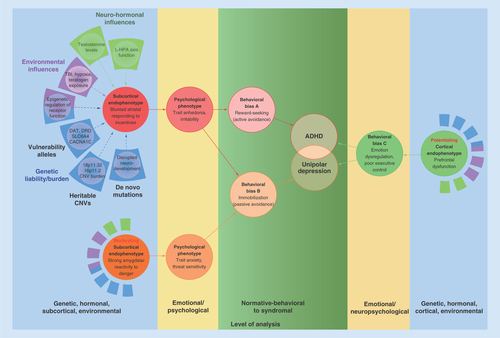Figures & data
Relations among genotypes, endophenotypes and phenotypes (A) and putative differences in measurement precision (B). Endophenotypes, which can be specified at many levels of analysis including neurobiological and behavioral, fall along pathways between (i.e., ‘bridge’) genotypes and phenotypes. A traditional assumption is that measurement precision of endophenotypes exceeds that of phenotypes (see text). The leftmost graph of (B) depicts perfect measurement precision of a dichotomous genetic vulnerability, distributed in equal proportions (50:50) in a sample of n = 1000. This level of precision is associated with genotyping a monogenic trait. The middle graph depicts measurement of an endophenotype of large effect size. The right graph depicts a phenotype measured with 50% error – a situation common to ratings of observed behavior [Citation16]. As envisioned by Gottesman and Gould [Citation3], better measurement precision of endophenotypes facilitates identification of genotypes.
![Figure 1. Levels of analysis and measurement precision of genotypes, endophenotypes, and phenotypes.Relations among genotypes, endophenotypes and phenotypes (A) and putative differences in measurement precision (B). Endophenotypes, which can be specified at many levels of analysis including neurobiological and behavioral, fall along pathways between (i.e., ‘bridge’) genotypes and phenotypes. A traditional assumption is that measurement precision of endophenotypes exceeds that of phenotypes (see text). The leftmost graph of (B) depicts perfect measurement precision of a dichotomous genetic vulnerability, distributed in equal proportions (50:50) in a sample of n = 1000. This level of precision is associated with genotyping a monogenic trait. The middle graph depicts measurement of an endophenotype of large effect size. The right graph depicts a phenotype measured with 50% error – a situation common to ratings of observed behavior [Citation16]. As envisioned by Gottesman and Gould [Citation3], better measurement precision of endophenotypes facilitates identification of genotypes.](/cms/asset/9abc0dba-5429-4ca5-b908-1d2ccf14fee2/ibmm_a_12321058_f0001.jpg)
Blunted striatal responding to incentives (left panel, top) arises from aggregation of and complex interactions among normal allelic variation, heritable CNVs, de novo mutations, epigenetic factors, environmental risk exposures and neurohormonal influences. Very few of these are necessary or sufficient to produce the resulting subcortical endophenotype. Low striatal responding predisposes to trait anhedonia/irritability (a psychological state), producing a behavioral bias to reward seeking, which can temporarily upregulate aversive mood. Importantly, this behavioral bias can be moderated by other subcortical systems, including the amygdala and its interconnections (left panel, bottom). Strong amygdalar response to threat (a moderating subcortical endophenotype) predisposes to trait anxiety (a largely independent psychological state), which moderates trait anhedonia to produce a behavioral bias to immobilization. In most cases, these behavioral biases are insufficient to eventuate in psychopathology in the absence of prefrontal cortex dysfunction (a potentiating cortical endophenotype). Poor prefrontal regulation of subcortically generated emotions is observed in almost all forms of psychopathology (see text). For the sake of clarity, specific frontal structures that regulate subcortical systems (dorsolateral prefrontal cortex, ventromedial prefrontal cortex, orbitofrontal cortex, anterior cingulate cortex), and interconnections among subcortical systems (extended amygdala, bed nucleus of the stria terminalis) are omitted.

